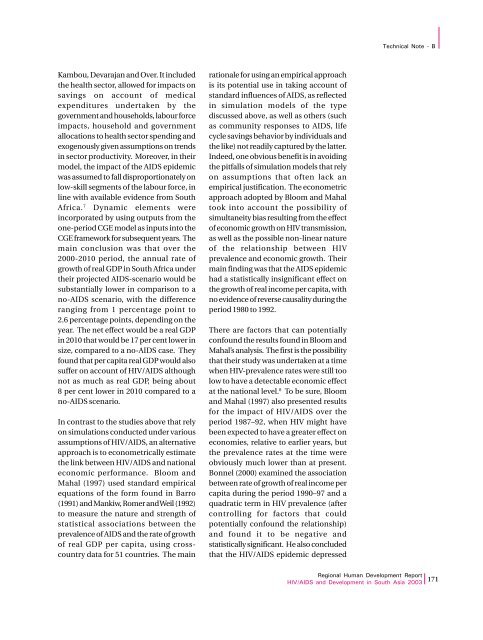Download Report - UNDP Asia-Pacific Regional Centre - United ...
Download Report - UNDP Asia-Pacific Regional Centre - United ...
Download Report - UNDP Asia-Pacific Regional Centre - United ...
You also want an ePaper? Increase the reach of your titles
YUMPU automatically turns print PDFs into web optimized ePapers that Google loves.
Technical Note - BKambou, Devarajan and Over. It includedthe health sector, allowed for impacts onsavings on account of medicalexpenditures undertaken by thegovernment and households, labour forceimpacts, household and governmentallocations to health sector spending andexogenously given assumptions on trendsin sector productivity. Moreover, in theirmodel, the impact of the AIDS epidemicwas assumed to fall disproportionately onlow-skill segments of the labour force, inline with available evidence from SouthAfrica. 7 Dynamic elements wereincorporated by using outputs from theone-period CGE model as inputs into theCGE framework for subsequent years. Themain conclusion was that over the2000-2010 period, the annual rate ofgrowth of real GDP in South Africa undertheir projected AIDS-scenario would besubstantially lower in comparison to ano-AIDS scenario, with the differenceranging from 1 percentage point to2.6 percentage points, depending on theyear. The net effect would be a real GDPin 2010 that would be 17 per cent lower insize, compared to a no-AIDS case. Theyfound that per capita real GDP would alsosuffer on account of HIV/AIDS althoughnot as much as real GDP, being about8 per cent lower in 2010 compared to ano-AIDS scenario.In contrast to the studies above that relyon simulations conducted under variousassumptions of HIV/AIDS, an alternativeapproach is to econometrically estimatethe link between HIV/AIDS and nationaleconomic performance. Bloom andMahal (1997) used standard empiricalequations of the form found in Barro(1991) and Mankiw, Romer and Weil (1992)to measure the nature and strength ofstatistical associations between theprevalence of AIDS and the rate of growthof real GDP per capita, using crosscountrydata for 51 countries. The mainrationale for using an empirical approachis its potential use in taking account ofstandard influences of AIDS, as reflectedin simulation models of the typediscussed above, as well as others (suchas community responses to AIDS, lifecycle savings behavior by individuals andthe like) not readily captured by the latter.Indeed, one obvious benefit is in avoidingthe pitfalls of simulation models that relyon assumptions that often lack anempirical justification. The econometricapproach adopted by Bloom and Mahaltook into account the possibility ofsimultaneity bias resulting from the effectof economic growth on HIV transmission,as well as the possible non-linear natureof the relationship between HIVprevalence and economic growth. Theirmain finding was that the AIDS epidemichad a statistically insignificant effect onthe growth of real income per capita, withno evidence of reverse causality during theperiod 1980 to 1992.There are factors that can potentiallyconfound the results found in Bloom andMahal’s analysis. The first is the possibilitythat their study was undertaken at a timewhen HIV-prevalence rates were still toolow to have a detectable economic effectat the national level. 8 To be sure, Bloomand Mahal (1997) also presented resultsfor the impact of HIV/AIDS over theperiod 1987–92, when HIV might havebeen expected to have a greater effect oneconomies, relative to earlier years, butthe prevalence rates at the time wereobviously much lower than at present.Bonnel (2000) examined the associationbetween rate of growth of real income percapita during the period 1990–97 and aquadratic term in HIV prevalence (aftercontrolling for factors that couldpotentially confound the relationship)and found it to be negative andstatistically significant. He also concludedthat the HIV/AIDS epidemic depressed<strong>Regional</strong> Human Development <strong>Report</strong>HIV/AIDS and Development in South <strong>Asia</strong> 2003 171
















